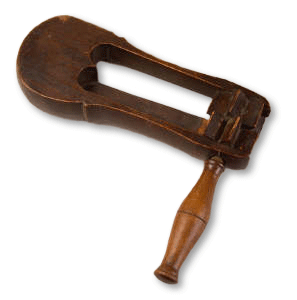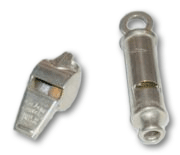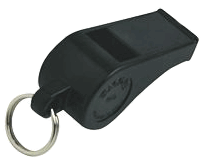This article was written by Edward J. “Ed” Steenberg, Saint Paul Police Historical Society.
Police Rattles & Whistles
The police whistle has its roots dating back to ancient China, where night watchmen would blow into the tops of acorns to alert the towns to invading Mongolians. In ancient Egypt two blades of the papyrus plant along the Nile River were held together in between the palms of alert security guards. By blowing into the palms the papyrus leaves would make a loud vibrant sound.
In England since the late nineteenth century Metropolitan Police Services constables have been issued with the "Metropolitan" whistle (bosun or boatswain's whistle). Prior to this, constables used hand rattles or nightsticks for signal purposes. All three were used to call for back-up in areas where neighborhood beats overlapped, and following their success in London, the whistle was adopted by most countries in United Kingdom, and around the world.

The origin of the rattle is not clear, but what has come to be known as the "Victorian Police Rattle" came into use sometime in the late seventeenth or early eighteenth century when night watchmen and/or village constables began using them to "raise the alarm". They proved to be an ideal method to summon aid, sound the fire alarm, or, just generally get folks attention. A traditional rattle was constructed of wood, usually oak, where one or two blades are held in a frame and a ratchet turned – generally by swinging – to make the blades 'snap' thus creating a very loud noise.
A typical Victorian Police Rattle can be found on display on the second floor of the Saint Paul Police headquarters building at 367 Grove Street. Not much different than the vintage ratchet style (tin w/wooden handle) Halloween noisemakers that your children use, today.
When Sir Robert Peel's Metropolitan Police was formed in 1829 the rattle was a standard piece of equipment issued to each London Bobby. Made to fit neatly into specially made pockets in the swallow tails of their coats, this rattle was one-bladed and had a folding handle. It was weighted with two lead plugs to make it swing easier and this also made it become a formidable weapon if necessary.
Rattles were used by police forces, fire brigades, and military units across the British Empire up through WW I. In 1883 the Metropolitan Police conducted tests and found that the sound from a whistle, already being used in some provincial forces, could be herd at 1000 yards – almost twice the effective distance of a rattle. Not only that, but the rattles were somewhat cumbersome, awkward to operate and prone to rot/warping. Constables were often subject to attacks from their own rattles. In 1884 whistles were issued in place of rattles and by 1887 all rattles had been withdrawn from use by the Met.
 Of interesting note is the fact that the original London police whistle was the "pea whistle", and it wasn't until the early twentieth century that they switched to the air whistle, often called the "Metropolitan" or bosun's whistle.
Of interesting note is the fact that the original London police whistle was the "pea whistle", and it wasn't until the early twentieth century that they switched to the air whistle, often called the "Metropolitan" or bosun's whistle.
Early Saint Paul police officers on the beat communicated with each other with the same tools of the trade.
If a sergeant had gone over an officer's beat and was unable to find him, he would then go to its center and each extremity and tap his nightstick twice. This was known as a "call rap." The officer would answer in like manner. If the visiting supervisor required the presence of the officer, he would give a single rap. In lieu of the nightstick, a whistle could be used.
If an officer on his beat required the presence of another officer on an adjoining beat, he would, in ordinary cases, give a single rap or whistle, which would be answered in like manner. Then the officer making the call would again give a single rap or whistle in answer. In case of fire, riot or other emergency, he would give three taps or whistles in quick succession and all officers hearing it would answer by a single rap or whistle and immediately come to the assistance of the officer making the call. If an officer was in pursuit of a person at night, he was, from time to time, to give a single rap or whistle to inform other officers of his route.
Please note that the Saint Paul Police Departmental Manual of 1882 includes Rule No. 74, that states in part that when a disturbance occurs… "If he is opposed in the performance of his duty, he shall blow his whistle, and the policemen who hear it shall answer the same by forthwith proceeding to his assistance."
The Acme Thunderer metal or plastic police whistle that we are most familiar with (also called a pea whistle) contain a small light ball, called the pea, which rattles around inside, creating a chaotic vibrato effect that intensifies the sound. In Saint Paul the police whistle has been a part of the uniform almost from the beginning, and is mentioned in all of our historic police manuals.

Police whistles fell into disuse in many countries in the mid-1900s, when early hand-held radios were brought into service. With the rise of the motor car, the whistle was no longer usefully audible in urban areas. The whistle is still used by some police forces today, especially in traffic assignments, and engraved ceremonial versions are sometimes presented to police officers upon occasions such as their retirement.
Many of our retirees remember the days prior to the hand-held radios, when they went to their beat by streetcar or bus, and reported back to headquarters from "call boxes" on the corner, at least once an hour. Some of the call boxes had a light or bell on top that would warn the beat officer of an incoming message.
They also remember that the whistle was a mandatory piece of equipment brought to roll call, the same as their handgun, pocket knife, notebook, and dime. And if you checked their pockets, you'd probably find a streetcar guide and, of course, their call box key.
Many of them, also, had to work traffic details during rush hour in the various heavily used intersections. I can still hear the long single blast, meaning "stop" and the chirping sound of the whistle as the officer signaled traffic to "move on."
